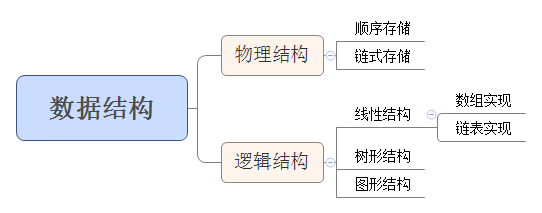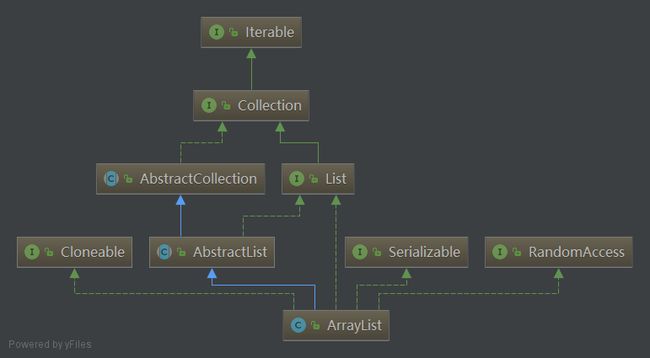概述
在分析ArrayList源码之前,先看一下ArrayList在数据结构中的位置,常见的数据结构按照逻辑结构跟存储结构如下:
先看看源码的注释:
- Resizable-array implementation of the List interface. Implements all optional list operations, and permits all elements, including
null. In addition to implementing the List interface,
this class provides methods to manipulate the size of the array that is
used internally to store the list. (This class is roughly equivalent to
Vector, except that it is unsynchronized.) - 实现了List接口的可调整大小的数组,也就是经常说的动态数组,实现了所有的可选的列表的操作,并且能够插入任何元素,包括空值。除了实现了List接口之外,对于内部存储的数组,也提供了相应的改变数组大小的方法。(这个类除了不是线程安全的,几乎可以相当于Vector)
很明显,ArrayList是一个线性结构,底层通过数组实现,并且是动态数组。
下面看一下ArrayList的继承关系,这个是通过IDEA生成的继承关系图,很清晰,终于不用自己画了。
通过图可以看到ArrayList继承自AbstractList,并且实现了List
正文
成员变量
//序列化ID
private static final long serialVersionUID = 8683452581122892189L;
//默认的初始化数组的容量为10
private static final int DEFAULT_CAPACITY = 10;
//共享的空数组,也就是调用空的构造方法的时候会进行默认用这个数组进行初始化
private static final Object[] EMPTY_ELEMENTDATA = {};
//数组缓冲区,也就是从来存放List元素的数组。ArrayList的容量就是缓冲区数组的长度。对于一个空数组,在添加第一个元素的时候,List的容量会被设置成默认的DEFAULT_CAPACITY,也就是10,
transient Object[] elementData;
//elementData的长度
private int size;
构造方法
构造一个空数组,采用默认容量(Constructs an empty list with an initial capacity of ten)
public ArrayList() {
super();
this.elementData = EMPTY_ELEMENTDATA;
}
public boolean add(E e) {
ensureCapacityInternal(size + 1); // Increments modCount!!
elementData[size++] = e;
return true;
}
private void ensureCapacityInternal(int minCapacity) {
if (elementData == EMPTY_ELEMENTDATA) {
minCapacity = Math.max(DEFAULT_CAPACITY, minCapacity);
}
ensureExplicitCapacity(minCapacity);
}
前面有提到过,当初始化数组为空的时候,在add的时候会进行判断,如果数组的长度为0,数组的长度就是默认的数组长度
构造一个空的数组,自定义数组容量(Constructs an empty list with the specified initial capacity)
public ArrayList(int initialCapacity) {
super();
if (initialCapacity < 0)
throw new IllegalArgumentException("Illegal Capacity: "+
initialCapacity);
this.elementData = new Object[initialCapacity];
}
这个跟上面的区别在于创建了一个新的数组,数组的最大长度就是传入的初始化容量,数组的长度为0。
传入一个集合进行初始化(Constructs a list containing the elements of the specified collection, in the order they are returned by the collection's iterator.)
public ArrayList(Collection c) {
elementData = c.toArray();
size = elementData.length;
// c.toArray might (incorrectly) not return Object[] (see 6260652)
if (elementData.getClass() != Object[].class)
elementData = Arrays.copyOf(elementData, size, Object[].class);
}
数组的长度就是传入的集合的长度,将集合传入缓冲数组
Add方法
在末尾添加一个元素(Appends the specified element to the end of this list.)
public boolean add(E e) {
ensureCapacityInternal(size + 1); // Increments modCount!!
elementData[size++] = e;
return true;
}
在指定位置添加一个元素(Inserts the specified element at the specified position in this list.)
public void add(int index, E element) {
//判断index是否合乎规范
if (index > size || index < 0)
throw new IndexOutOfBoundsException(outOfBoundsMsg(index));
//检查是否需要扩容
ensureCapacityInternal(size + 1); // Increments modCount!!
//拷贝数组
System.arraycopy(elementData, index, elementData, index + 1,
size - index);
//进行赋值
elementData[index] = element;
//将数组的长度自增
size++;
}
在末尾添加一个集合(Appends all of the elements in the specified collection to the end of this list)
public boolean addAll(Collection c) {
Object[] a = c.toArray();
int numNew = a.length;
ensureCapacityInternal(size + numNew); // Increments modCount
System.arraycopy(a, 0, elementData, size, numNew);
size += numNew;
return numNew != 0;
}
在指定位置添加集合(Inserts all of the elements in the specified collection into this list, starting at the specified position)
public boolean addAll(int index, Collection c) {
if (index > size || index < 0)
throw new IndexOutOfBoundsException(outOfBoundsMsg(index));
Object[] a = c.toArray();
int numNew = a.length;
ensureCapacityInternal(size + numNew); // Increments modCount
int numMoved = size - index;
if (numMoved > 0)
System.arraycopy(elementData, index, elementData, index + numNew, numMoved);
System.arraycopy(a, 0, elementData, index, numNew);
size += numNew;
return numNew != 0;
}
Add操作有如上几个重载方法,仔细观察一下,大同小异,我们选择第二个重载方法,也就是在指定位置添加一个元素:
- 判断index是否合理
- 检查是否需要扩容
- 拷贝数组
- 进行赋值
- 将数组的长度自增
这里面比较有营养的就是第二步了,下面重点分析第二步:
调用ensureCapacityInternal(size++1)
private void ensureCapacityInternal(int minCapacity) {
if (elementData == EMPTY_ELEMENTDATA) {
minCapacity = Math.max(DEFAULT_CAPACITY, minCapacity);
}
ensureExplicitCapacity(minCapacity);
}
传入了此时数组需要的长度,只要数组为初始化的时候没有指定容量,就会在minCapacity(size+1)跟DEFAULT_CAPACITY中间取一个最大值,之所以这样,是因为如果将数组的容量设置成太小,会导致数组频繁的扩容,影响性能。
调用ensureExplicitCapacity(minCapacity)
private void ensureExplicitCapacity(int minCapacity) {
//这个变量来自于ArrayList的父类AbstractList,主要用来记录集合的操作次数
modCount++;
// overflow-conscious code
//如果此时需要的数组长度大于数组本身的长度,则进行扩容
if (minCapacity - elementData.length > 0)
grow(minCapacity);
}
执行扩容操作grow(minCapacity)
private void grow(int minCapacity) {
// overflow-conscious code
//数组当前的容量
int oldCapacity = elementData.length;
//扩容后新数组的容量,增大了0.5倍
int newCapacity = oldCapacity + (oldCapacity >> 1);
//如果扩容后的数组比当前的所需要的数组长度要小,则区当前需要的长度
if (newCapacity - minCapacity < 0)
newCapacity = minCapacity;
//将扩容后的数组长度跟定义的数组最大长度进行比较,防止越界
if (newCapacity - MAX_ARRAY_SIZE > 0)
newCapacity = hugeCapacity(minCapacity);
// minCapacity is usually close to size, so this is a win:
//进行扩容操作
elementData = Arrays.copyOf(elementData, newCapacity);
}
Remove方法
remove指定位置元素(Removes the element at the specified position in this list)
public E remove(int index) {
if (index >= size)
throw new IndexOutOfBoundsException(outOfBoundsMsg(index));
modCount++;
E oldValue = (E) elementData[index];
int numMoved = size - index - 1;
if (numMoved > 0)
System.arraycopy(elementData, index+1, elementData, index,
numMoved);
elementData[--size] = null; // clear to let GC do its work
return oldValue;
}
移除某个具体元素(Removes the first occurrence of the specified element from this list,if it is present. If the list does not contain the element, it is unchanged)
public boolean remove(Object o) {
if (o == null) {
for (int index = 0; index < size; index++)
if (elementData[index] == null) {
fastRemove(index);
return true;
}
} else {
for (int index = 0; index < size; index++)
if (o.equals(elementData[index])) {
fastRemove(index);
return true;
}
}
return false;
}
//此时执行的代码就是删除指定位置的代码
private void fastRemove(int index) {
modCount++;
int numMoved = size - index - 1;
if (numMoved > 0)
System.arraycopy(elementData, index+1, elementData, index,
numMoved);
elementData[--size] = null; // clear to let GC do its work
}
仔细观察一下上面两个重载方法,其实是差不多的,删除元素分两步走:
- 找到这个元素
- 执行删除操作
比较简单,不过多描述
Set方法
public E set(int index, E element) {
if (index >= size)
throw new IndexOutOfBoundsException(outOfBoundsMsg(index));
E oldValue = (E) elementData[index];
elementData[index] = element;
return oldValue;
}
直接替换掉对应的元素
查找索引操作
寻找元素第一次出现的下标(Returns the index of the first occurrence of the specified element)
public int indexOf(Object o) {
if (o == null) {
for (int i = 0; i < size; i++)
if (elementData[i]==null)
return i;
} else {
for (int i = 0; i < size; i++)
if (o.equals(elementData[i]))
return i;
}
return -1;
}
寻找最后出现的某个元素的索引(Returns the index of the last occurrence of the specified element in this list)
public int lastIndexOf(Object o) {
if (o == null) {
for (int i = size-1; i >= 0; i--)
if (elementData[i]==null)
return i;
} else {
for (int i = size-1; i >= 0; i--)
if (o.equals(elementData[i]))
return i;
}
return -1;
}
这些都是通过遍历对元素进行查找,一个是从头到尾遍历,一个是从未到头遍历,查到结构就返回对应的下表,否则返回-1.
Get方法
public E get(int index) {
if (index >= size)
throw new IndexOutOfBoundsException(outOfBoundsMsg(index));
return (E) elementData[index];
}
总结
ArrayList的特点
- 有序的,元素可以重复
- 查询快,增删慢
- 当容量不够的时候,会进行扩容至当前size的1.5倍
- 非线程安全
关于ArrayList的源码就分析到这里,因为底层的实现是数组,所以不管是扩容还是其它的增删改查操作都是对数组进行操作,所以只要对数组足够了解,基本上还是挺好理解的。

